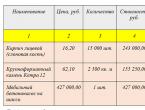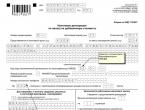Accounting entries for goods receipt. Accounting entries for the sale of goods and services. Accounting for sales of goods at sales prices
The goods belong to inventories and are intended for sale. In this article, we will consider how commodity assets arrive at the enterprise, at what prices they are accepted for accounting. We will also analyze the accounting for the receipt of goods and the entries that reflect this process.
Trade organizations engaged in the acquisition of goods for their further resale may use one of the following accounting methods to accept them for accounting:
- at purchase price;
- at sales prices;
- at discounted prices.
Only retail enterprises can accept goods for accounting at sales prices; they can choose any of these methods.
Wholesale enterprises can use either purchase price or discount prices. The second method is not available to them.
The organization must decide how it will accept goods and reflect its decision in the Accounting Policy Order.
This method is the most common. Goods are accepted for accounting at actual cost, which may include the supplier’s price and other costs associated with transportation and procurement of goods (transportation and procurement costs).
An organization can include only the supplier's price in the purchase price and allocate transportation and procurement costs separately as selling expenses, or it can include material and equipment in the purchase price. Read more about this.
Whether or not to include delivery and procurement costs in the purchase price is up to the organization to decide independently. The decision made should be reflected in the accounting policies of the organization.
To account for commodity assets, there is account 41 “Goods”, this is the debit of which reflects the receipt of an asset - goods, and the credit - its write-off, disposal.
When goods arrive at the enterprise, posting D41 K60 is performed, if an invoice with allocated VAT is attached, and the organization is a VAT payer, then the amount of VAT is allocated separately to posting D19 K60, after which it is sent to the deduction D68.VAT K19.
If an organization decides to include transportation and procurement costs in the purchase price, then the entry for accounting for goods and materials is D41 K60.
If TZR are accounted for separately as sales expenses, then a separate sub-account is opened in which delivery and procurement costs will be accumulated; the posting looks like D44.TR K60.
Postings upon receipt of goods at purchase prices:
Receipt at sales prices for retail trade
At sales prices, only retail trade enterprises can accept commodity values for accounting. In this case, additional account 42 “Trade margin” is used for accounting, which is necessary to reflect the trade margin on the purchased product, which is defined as the difference between the purchase and sale costs.
Upon receipt, a D41 K60 posting is initially made for an amount equal to their purchase price, according to the supplier’s documents.
After this, the trade margin is reflected by posting D41 K42 in the amount of the margin.
In the future, the trade margin on account 42 will be reversed (subtracted) when goods are disposed of from account 41.
When the goods are sent for sale, the trade margin on account 42 will be reversed by posting D90/2 K42.
If the goods are sent to the organization’s own needs (entry D44 K41), then the markup from account 42 is reversed (subtracted) into expenses by entry D44 K42.
If commodity valuables are written off as shortages or damage (entry D94 K41), then the markup is reversed by entry D94 K42.
Example of receipt in retail trade:
The organization accounts for goods at sales prices, the trade margin is 25%. The organization purchased a consignment for a fee in the amount of 59,000 rubles, including VAT of 9,000 rubles. Delivery costs amounted to 5,900 rubles, including VAT of 900 rubles. TZR are included in the cost of goods.
If you have a need to accept goods for accounting into a warehouse, then you have come to the right place. The article will simply and clearly explain how the receipt of goods into the warehouse is accounted for, at what cost they can be capitalized, and what journal entries should be made.
In the next article we will look at how the sale of goods is formalized and what transactions are made.
The receipt of goods at the warehouse must be accompanied by the execution of the relevant primary documents. These, first of all, include or, which contains all the necessary data about the buyer and seller, information about the product (price, quantity, name). Also, the invoice must be certified with the signatures of responsible persons and a round seal. Instead of a round seal, the buyer can use .
This primary document is drawn up in two copies, one for the buyer, the other with the buyer’s seal remains with the seller.
Also, as accompanying documents for goods, a separate VAT and invoice for payment for the goods can be used.
Recently, it has become possible to use a single document, called a universal transfer document, which can be issued instead of a delivery note and an invoice. Read more about this.
Video lesson. Receipt of goods in 1C Accounting: step-by-step instructions
Practical video lesson on accounting for receipt of goods in 1C Accounting 8.3. Hosted by site expert Olga Likina: “Accounting for Dummies”, payroll accountant at M.Video Management LLC. The lesson provides step-by-step instructions for recording the receipt of goods.
Accounting for the receipt of goods at the warehouse
To account for goods, account 41 is used. On the debit of the account. 41 takes into account the receipt of goods, and the loan takes into account their disposal.
When goods arrive at the warehouse, they can be accounted for in several ways:
- At sales prices;
- At discounted prices;
- At purchase prices (at actual cost).
Accounting at discount and purchase prices is more common in wholesale trade or manufacturing enterprises. At retail enterprises, accounting is carried out either at actual cost or at sales prices.
The most common is the latter accounting method.
Receipt of goods at actual cost
Goods are accepted for accounting at the cost indicated in the supplier’s documents. If the supplier allocates value added tax and presents invoices, then the tax amount is allocated to a separate sub-account for reimbursement from the budget. And the goods come at cost without tax.
Actual cost may also include . The organization itself decides to take these expenses into account in account 41 or allocate them separately as sales expenses (in the debit of account 44). The chosen option for accounting for goods and materials is reflected in the accounting policy.
Postings:
If commodity assets were purchased with borrowed funds, then interest accrued by the bank can also be included in the cost price, that is, taken into account as a debit to the account. 41 (if interest was accrued before these valuables were posted to the warehouse) or, according to the general rule, by debit of the account. 91/2 included. The chosen option for accounting for interest on a loan is also reflected in the accounting policy order.
Example:
The organization took out a loan of 120,000 rubles. Goods were purchased for this amount, including value added tax of 20,000 rubles. (You can read how to calculate VAT). The bank accrued interest in the amount of 15,000, which, according to the organization’s accounting policy, is taken into account as part of operating expenses. The organization sold this lot for 180,000, including tax of 30,000 rubles.
Postings:
Sum | Debit | Credit | Operation name |
Received a loan from a bank |
|||
Purchased goods are credited to the warehouse |
|||
Tax on purchased assets allocated |
|||
Interest accrued on the loan |
|||
Reflected sales revenue |
|||
Payment received from buyer |
Accounting for receipt of goods at sales prices
If commodity values are taken into account at sales prices, then an additional account is used. 42 “Trade margin”, which reflects the trade margin on the purchased goods, including the organization’s income and VAT.
Posting to reflect the trade margin: D41 K42.
When selling, the amount of the trade margin is reversed (subtracted) by posting D90/2 K42.
If a product is marked down, the amount of the markdown is written off at the expense of the previously established trade margin (D41 K42 is reversed). If the amount of the markdown exceeds the size of the trade margin, then the resulting difference is included in other expenses D91/2 K41.
If goods are written off for own needs D44 K41, then the trade margin is written off (reversed) there D44 K42.
If goods are disposed of as a result of shortages or damage and are written off by posting D94 K41, then the trade margin is also written off (reversed) to the debit of the account. 94 “Shortages and losses from damage to valuables” – D94 K42.
Example
The organization bought goods in the amount of 12,000, including VAT 2,000. The VAT rate on sales is 18%. The markup is set at 30%.
- We calculate the trade margin: (12000 - 2000) x 30% = 3000.
- We calculate value added tax on sales: (10000 + 3000) x 18% = 2340.
- We calculate the total amount of the trade margin: 3000 + 2340 = 5340.
Postings in this example:
Sum | Debit | Credit | Operation name |
Purchased goods were capitalized into the warehouse (excluding VAT) |
|||
Tax allocated for purchased goods |
|||
VAT tax deduction has been made |
|||
Payment transferred to the supplier |
|||
Trade margin reflected |
|||
The cost of goods for sale has been written off |
|||
The amount of the trade margin was reversed (deducted) |
|||
Reflected sales revenue |
|||
VAT charged on goods sold |
|||
Payment received from buyer |
Receipt of goods - accounting entries will depend on how the company plans to use the acquired value (resell, use in the manufacture of products, etc.) and other nuances. Which accounting accounts are involved in recording transactions for the receipt of goods and services, when the goods can only be accounted for on the balance sheet? Find answers to these and other related questions in our material.
What nuances affect the reflection of goods and services in accounting?
In the business activities of any company, the need regularly or periodically arises to purchase goods and (or) services from third-party sellers (performers, suppliers). If material assets are purchased in a retail chain, from the seller’s point of view they are all goods. However, when posting a purchase to the company (buyer) accounts, it is necessary to correctly classify it as:
- goods for resale (account 41 “Goods”);
- fixed assets (accounts 08 “Investments in non-current assets”, 01 “Fixed assets”);
- MPZ (accounts 10 “Materials”, 15 “Procurement and acquisition of material assets”, 16 “Deviation in the cost of material assets”).
The situation with the purchase of services is also ambiguous. The determining factor here is the purpose of their acquisition. For example:
In each case, the transactions for the purchase of goods and services will be different.
What is a service and what types of services exist, find out from this material.
Basic accounting entries for the purchase of goods and services (example)
An example will help us understand the transactions for the receipt of goods and services.
Manufacturing Company LLC purchased the following goods from its supplier (a large retail chain):

To deliver the concrete pump, the company used the services of the transport company PJSC Pomoschnik. Taking into account the range of movement and the large size of the cargo, PJSC Pomoshchnik estimated the cost of its service at 45,490 rubles. (without VAT).
The accountant of Production Company LLC took into account the planned areas of use of purchased assets (column 6) and made the followingaccounting entries for receipt of goods and services:

We will tell you in this publication whether a seller can issue one UTD for goods and services.
When should goods be taken into account off balance sheet?
There are situations when there are valuables of other persons on the company’s territory. For example, when accepting a product, a defect is detected - until the supplier picks up the product, the buyer is obliged to ensure its safety (Clause 1, Article 514 of the Civil Code of the Russian Federation). Or the company provides goods storage services. In such cases, material value not related to the company's own property is subject to off-balance sheet accounting.
The postings for posting goods to the balance sheet will be as follows:

What needs to be taken into account in off-balance sheet accounts and how the company will be punished if off-balance sheet accounting is not organized, learn from this material.
Results
The main posting upon receipt of goods: Dt 41 “Goods” Kt 60 “Settlements with suppliers and contractors”. If the value acquired as a commodity will be used in the company’s activities, then it must be reflected in the debit of account 10 “Materials” or in the accounts of non-current assets. The procedure for recording the purchased service depends on its purpose and can be reflected as a debit to cost accounts or included in the initial cost of the asset.
The sale of goods and services is the transfer on a paid basis of ownership of goods and the provision of services for a fee by one person to another person. We will tell you about standard accounting entries for the sale of goods and services in our consultation.
Sales of goods: postings
The main account for accounting for the sale of goods in accordance with the Chart of Accounts and Instructions for its use () is account 90 “Sales”. This account reflects the proceeds from the sale of goods, as well as expenses associated with the sale and VAT accrued on sales.
Let's present typical transactions for the sale of goods in the table:
The presented set of transactions assumes that revenue is recognized at the time of shipment of goods.
However, a situation is possible when, in accordance with the contract, ownership of the goods passes to the buyer, for example, at the time of payment. In this case, revenue is not recognized at the time of shipment, because one of the conditions for its recognition is not met - the transfer of ownership to the buyer (clause “d”, clause 12 of PBU 9/99). But since the goods actually leave the warehouse and are written off from accounting, at the time of shipment account 45 “Goods shipped” is used:
| Operation | Account debit | Account credit |
|---|---|---|
| Goods were shipped to the buyer under a contract with a special procedure for transfer of ownership (after payment) | 45 | 41 |
| VAT is charged at the time of shipment | 76 “Settlements with various debtors and creditors” | 68 |
| Payment received from buyers | 51, 52, etc. | 62 |
| Revenue from the sale of goods is recognized | 62 | 90, subaccount “Revenue” |
| The cost of previously shipped goods has been written off | 90, subaccount “Cost of sales” | 45 |
| VAT accrued at the time of shipment of goods is taken into account | 90, subaccount “VAT” | 76 |
| Expenses associated with the sale of goods are written off | 90, subaccount “Sales expenses” | 44 |
When they talk about reverse sales, they mean a set of accounting entries that the buyer must make in his accounting when returning the goods to the supplier. You can read about standard transactions when returning goods for various reasons in.
Free sales: wiring
Sometimes sales also mean the gratuitous transfer of goods. Naturally, in this case, the “seller” does not reflect income from the disposal of goods. And expenses associated with the sale will not be taken into account in account 90. To account for the gratuitous transfer, account 91 “Other income and expenses” is used (Order of the Ministry of Finance dated October 31, 2000 No. 94n, clause 11 PBU 10/99).
Free sales of goods will be accounted for as follows:
Sales of services: postings
The main difference between services and goods is that services are consumed directly at the time of their provision. In this regard, expenses associated with the provision of services collected in accounts 20 “Main production”, 23 “Auxiliary production”, 29 “Service production and farms” are written off to the debit of account 90 at the time of provision of services without their intermediate recording in the account, similar to account 41.
Otherwise, the accounting entries for the provision of services will be similar to those given above.
Sales of goods or services are the main sources of income for a company. The sale is reflected in accounting either at the time of shipment or at the time of payment. Each shipment involves its own postings.
Sales of goods are reflected in the debit of the “Cost” subaccount () and Credit 41 of the account, the subaccounts for which are determined by the type of trade (wholesale/retail, etc.):
- Revenue from the sale of goods is reflected in the Credit of account 90 subaccount “Revenue” in correspondence with the account.
Sales of goods can be carried out through an intermediary. Then it is necessary to make entries Debit 45 Credit 41 “Goods in warehouses”. As inventory items are sold, business entries are made to debit account 90 “Cost” and credit. When exporting goods, the same transactions are made.
In the main taxation system, it is necessary to pay VAT on sales. The tax is reflected by posting Debit VAT Credit.
In retail trade, goods are sold at selling price. The markup is made according to . When selling at the end of the month, you need to make reversing entries:
- Debit 90 “Cost” Credit 42.
Postings for the sale of goods in wholesale trade
Usually it can be made by prepayment or upon shipment of the goods.
By prepayment
The organization then shipped goods worth 99,500 rubles. (VAT RUB 15,178).
Postings:
| Account Dt | Kt account | Wiring Description | Transaction amount | A document base |
| 99 500 | Bank statement | |||
| Issuing an invoice for advance payment | 15 178 | Ref. invoice | ||
| Revenue from or goods is taken into account | 99 500 | Packing list | ||
| VAT is charged on sales | 15 178 | Packing list | ||
| Sold goods written off | 64 000 | Packing list | ||
| Advance credited | 99 500 | Packing list | ||
| 99 500 | Invoice | |||
| Deduction of advance VAT | 15178 | Invoice |
By shipment
The organization shipped goods worth RUB 32,000 to the buyer. (VAT 4881 rub.). Payment was received after delivery.
Postings:
| Account Dt | Kt account | Wiring Description | Transaction amount | A document base |
| Revenue from sales of goods is reflected | 32 000 | Packing list | ||
| VAT is charged on sales | 4881 | Packing list | ||
| Sold goods written off | 385 | Packing list | ||
| An invoice for sales has been issued | 32 000 | Invoice | ||
| Payment received from buyer | 32 000 | Bank statement |
Retail sales of goods
For the day, trading revenue in the store amounted to 12,335 rubles. Accounting is kept at sales prices, the organization is on the UTII taxation system, and the outlet is automated. The money was deposited at the company's cash desk on the same day.
Postings:
| Account Dt | Kt account | Wiring Description | Transaction amount | A document base |
| Receipt of proceeds from the sale of goods | 9000 | Cashier's report | ||
| Write-off of goods sold at sales price | 9000 | Cashier's report | ||
| Proceeds deposited at the cash register | 9000 | Receipt cash order | ||
| Calculation of markup on goods sold | -3700 | Help - calculation of markup write-off |
Postings for sales or provision of services
When selling services, the same accounts are involved, only instead of 41 accounts there are 20 accounts, which collect all the costs that make up the cost.
The organization performed services in the amount of 217,325 rubles. The cost of the service was 50,000 rubles.
Postings for the provision of services.




